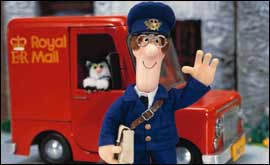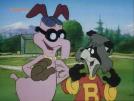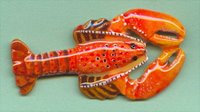 POSTMAN PAT
POSTMAN PAT
Made by: Woodlands Animation
Shown on: BBC
Shown by: 1982 onwards (original series)
Theme tune: “Postman Pat, Postman Pat, Postman Pat and his black and white cat/Early in the morning, just as day is dawning/He picks up all the post-bags in his van…”
A giant of the public sector workforce, Postman Pat began life as a series of books by John Cunliffe, which were adapted for the television by Ivor Wood, and few could have predicted what an household name and international celebrity he would quickly become.
The famous theme was sung by Ken Barrie, who also provided the voices, and Pat would pave the way for other local heroes - and busybodies - like Fireman Sam and Bob the Builder.
Postman Pat was the sole postal employee for the sleepy village of Greendale, located somewhere like the Yorkshire Dales. It was just as well everyone knew and liked him, because he was often side-tracked from his work, and the mail wasn’t always delivered on time or, in fact, at all. He lived at Forge Cottage with his wife, Sarah, their six year old son, Julian and, of course, Jess the cat. Jess would accompany Pat on his rounds in the chunky red van, registration PAT 1 (Royal Mail could have saved a lot of money if they hadn’t allowed low-grade employees to have personalised registration plates.)
First stop was always the post office, run in a pragmatic way by postmistress, Mrs Goggins, where he would collect all the mail to be delivered. The furthest port of call was Intake Farm, home of George Lancaster, a chicken farmer who dressed like a vagrant. If Greendale needed a village idiot, George was your man - he was kind of an outsider because he lived way up on the moors (no wonder Pat never lingered long there) and he was known to pay his bills in eggs from his prize laying hens.
Back in the relative safety of the village, there was Mrs Julia Pottage, and her 6 year old twins, Katy and Tom. Although she was a farmer’s wife, there didn’t appear to be a Mr Pottage any more, although she did employ a shepherd, the ginger-bearded Peter Fogg. Far be it for me to imply anything...
Postman Pat was ahead of its time with its trend portraying in single-parents. There was Mr Pringle, the lone schoolmaster, who had sole charge of his nine year old boy, Charlie - he might have got on well with Dr Sylvia Gilbertson, who lived with her precocious daughter, Sara. Sara was best friends with Lucy Selby, who lived across the road with her dad, PC Selby. Now, being a single man himself, perhaps PC Selby would have appreciated a bit of female company from Miss Rebecca Hubbard…or maybe not. Miss Hubbard was a dyed-in-the-wool spinster, who cycled to choir practice every day, and liked organising village activities - in short, she was too daunting a prospect for any man.
One happy family in Greendale was the Thompsons, who had a farm at Thompson Ground. Alf Thompson, a hardy, moustachioed man, had really fallen on his feet with his attractive wife, Dorothy, and the two of them had a son, 11 year old Bill. Bill, who always wore a yellow mac and had unkempt black hair, was the oldest pupil at Greendale School, and was therefore responsible for collecting the mail from Pat when he passed by the school. He also lent Pat his ice-skates with the intention of making winter deliveries easier - of course, it had no such effect, but they made a whole episode out of it.
Not everyone in Greendale was in the farming industry, as someone had to survive the BSE crisis. Ted Glen was the local handyman (“Leave it to me, leave it to me/I’ll try to fix it up for you as quickly as can be” was his musical promise), and he could turn his hand to any DIY conundrum. It was he who fixed the rusted village well when there was a drought, but why he didn’t do it earlier is anyone’s guess. Sam Waldron was the only character who didn’t actually live in Greendale; he owned a mobile grocer’s shop, and was a bit of spiv in the mould of Dad’s Army’s Private Walker. The Reverand Timms was the kindly, white-haired vicar of the village church, and he had a trite observation for any occasion (“Seek and ye shall find” he helpfully advised Pat, when looking for Katy Pottage’s lost doll.) But he did help Pat on one occasion, when he and Miss Hubbard rang the church bells to guide a lost Pat through the thick fog.
Like most rural communities, there was an ageing population, and Greendale had its fair share of fossils. Granny Dryden was deaf as a post, and never had any batteries in her hearing-aid - she was also adept at knitting itchy vests for the people of the village. Meanwhile, the retired Major Forbes was living at Garner Hall; a model pensioner, Forbes enjoyed cooking, collecting antiques, and rearing a heard of prize milking cows. But he’d probably still take out a shotgun if you wandered on to his land.
Only thirteen episodes of Postman Pat were made initially, but in an almost unique move, another thirteen original shows were made at the end of the nineties. Pat was sent careening into the modern age, which could be observed by a magazine in Mrs Goggins’ post office, which appeared to have Mulder and Scully on the front of it.
But did you know that Pat’s surname is Clifton? Eh? Not many people have access to that kind of privileged information.
SQUARE EYES RATING: 9/10
(Thanks to www.bbc.co.uk for the borrowed pic)
 RAGDOLLY ANNA
RAGDOLLY ANNA 


